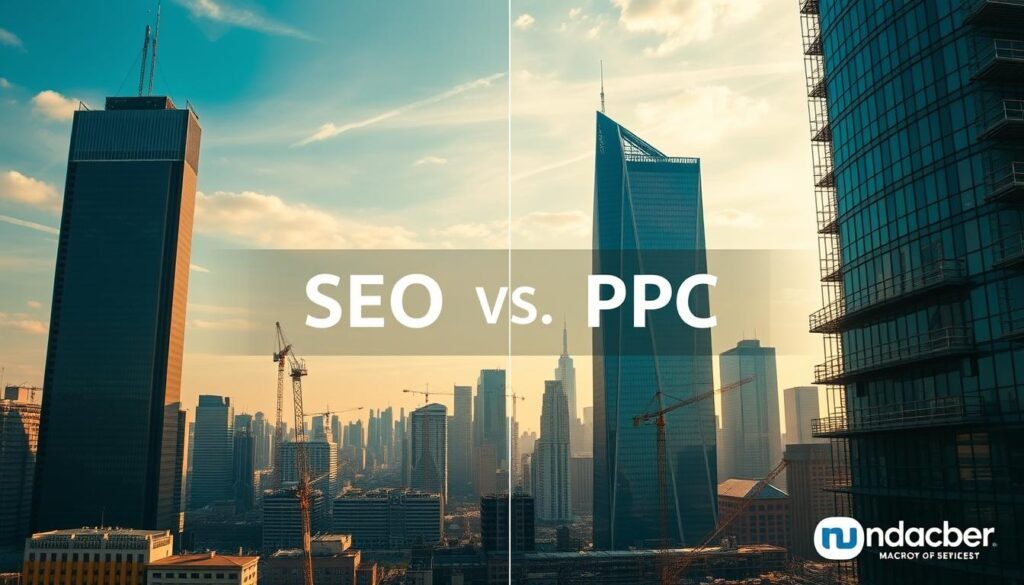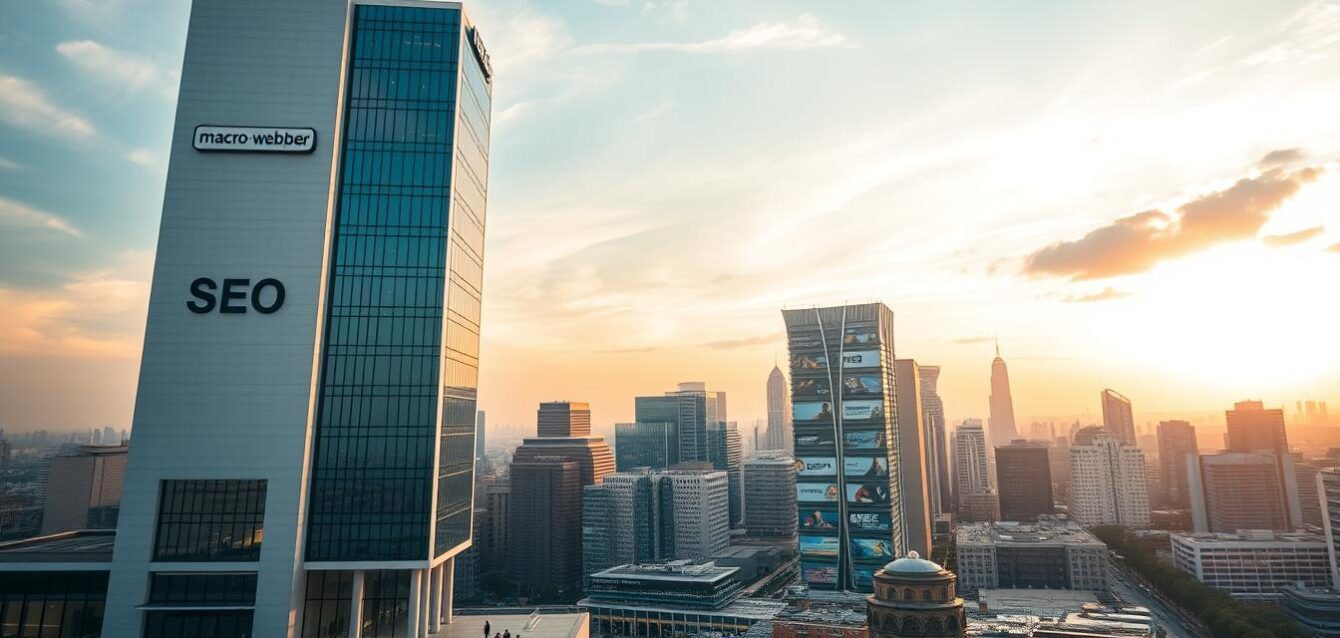Did you know that 64% of marketers prioritize long-term growth strategies over quick wins? In the competitive world of architecture, standing out online is crucial. But choosing between organic visibility and paid promotions can be tricky.
Organic search results grab attention with a 31.7% click-through rate for top positions. Meanwhile, paid search visitors are 35% more likely to convert. Both approaches have unique strengths for attracting clients.
Macro Webber specializes in crafting tailored digital solutions for architecture firms. Whether you need sustainable growth or instant exposure, our team balances strategy with execution. Reach us at hello@macrowebber.com or +91 (353) 405-7665 to explore options.
Key Takeaways
- Top organic results earn significantly more clicks than paid listings
- Paid search drives higher conversion rates per visit
- Blending both strategies maximizes online visibility
- Architecture firms benefit from customized digital approaches
- Professional guidance optimizes marketing investments
Introduction: SEO vs. Paid Ads for Architects
Architecture firms face unique challenges in digital visibility. Unlike generic businesses, you need strategies that showcase creativity, expertise, and local presence simultaneously.
Mobile searches dominate discovery. 67% of local clients find firms through map apps. If your listings aren’t optimized, you’re missing prime opportunities.
Competition in search results is fierce. Top spots go to firms blending long-term growth via search engine optimization with tactical paid campaigns. Here’s why:
- Cost efficiency: Small businesses spend 7x more on PPC than organic efforts.
- ROAS: Google Ads average 200% return on ad spend for targeted services.
- Sustainability: 55% of marketers call organic traffic “very important” for lasting results.
Macro Webber’s data-driven approach helps you balance both. We analyze metrics like:
- Click-through rates for high-intent keywords
- Conversion paths across devices
- Budget allocation for maximum impact
The best solution? A search engine marketing stack. This combines PPC’s immediacy with SEO’s compounding value—perfect for architecture firms scaling strategically.
What Is SEO for Architects?
Modern architecture firms thrive when their expertise reaches the right audience. Search engine optimization (SEO) ensures your designs and services appear prominently in organic results. Unlike generic ads, it builds lasting visibility tailored to your niche.
How Optimization Works for Architecture Firms
Specialized tactics match how clients discover firms. 82% see traffic boosts within six months of implementing structured strategies. Start with:
- Keyword research for residential vs. commercial projects
- Portfolio enhancements using alt-text for renderings
- Local listings optimized for multi-city practices
Key Elements of Architectural SEO
Technical and creative efforts combine for impact. Over half of firms invest in technical fixes for slow-loading sites. Meanwhile, content showcases awards and design philosophy. Prioritize:
- Structured data markup for project galleries
- Blogs explaining sustainable design principles
- Mobile-friendly layouts for on-the-go clients
“A well-optimized site acts as a 24/7 showcase,” notes one industry analyst. Pairing these strategies with consistent updates ensures long-term growth.
What Is PPC for Architects?
Pay-per-click advertising offers architecture firms instant visibility in search results. Unlike organic methods, it puts your services directly in front of clients actively searching for design solutions. When executed well, these campaigns drive qualified leads faster than traditional marketing.
How PPC Campaigns Benefit Architecture Businesses
Targeted ads deliver measurable results quickly. A well-structured campaign can boost consultation requests by 3x-5x with proper landing page optimization. Key advantages include:
- Precise audience targeting by project type, location, or budget
- Immediate visibility for competitive keywords
- Full control over daily spending and ad placements
“PPC allows architects to test messaging before committing to long-term strategies. The data reveals exactly what resonates with potential clients.”
Core Components of Successful PPC Ads
High-performing campaigns require strategic planning. Focus on these essential elements:
| Component | Architecture-Specific Tip |
|---|---|
| Ad Copy | Highlight specialty services like sustainable design or historic renovations |
| Keywords | Separate commercial and residential terms for better performance |
| Negative Keywords | Filter out DIY searches to improve lead quality |
| Bid Strategy | Adjust bids for high-value commercial projects |
| Conversion Tracking | Measure consultation requests as primary goals |
Regular A/B testing ensures continuous improvement. Try different visual formats for project showcases and monitor click-through rates. The right combination of elements maximizes return on ad spend while attracting ideal clients.
SEO vs. PPC for Architects: Key Differences
Digital marketing for design firms requires balancing immediate and long-term tactics. While both methods aim to increase visibility, their execution and outcomes vary significantly. Understanding these contrasts helps you allocate resources effectively.

Timeframe for Results
Organic growth takes patience. Most firms see traction after 4-6 months of consistent optimization. Paid campaigns, however, drive traffic within days. 53% of marketers prioritize featured snippets for gradual authority building.
PPC excels for time-sensitive promotions like limited consultation offers. Pairing both ensures steady visibility while testing new services.
Cost Structures Compared
Organic efforts demand ongoing content and technical investments. Paid ads operate on fixed budgets—you control daily spend. Local service ads for architects often cost more than broader campaigns but yield higher-quality leads.
Pro tip: Use PPC data to identify high-converting keywords for organic strategies. This reduces wasted spend over time.
Targeting Capabilities
PPC enables exact demographic filters, like project budgets or commercial clients. Organic search relies on intent-based keywords. Content clusters for specialties (e.g., sustainable design) help capture niche audiences.
“Map pack optimization dominates local searches, while paid ads target specific service areas. Combining both covers all discovery paths.”
- Local service ads appear above organic map results
- SEO content ranks for educational queries (e.g., “modern residential architecture trends”)
- PPC targets transactional phrases (“hire an architect near me”)
Pros and Cons: SEO for Architecture Firms
Building a strong online presence requires careful strategy selection for design professionals. Organic visibility offers unique benefits but comes with specific challenges you should consider.
Advantages of Long-Term SEO
Sustainable growth begins with proper optimization. Firms ranking organically gain 3x more credibility than paid listings according to recent surveys. The compounding effect means your efforts today keep delivering results for years.
Key benefits include:
- Higher conversion rates from trust-building content
- Lower cost per lead over time compared to ads
- Continuous traffic without ongoing campaign budgets
Challenges of Organic Search
While powerful, this approach demands patience and adaptation. The median domain authority for small firms sits at just 19, making competitive rankings difficult. Algorithm changes require constant content updates and technical maintenance.
Common obstacles architects face:
- Legacy websites needing structural improvements
- Substantial content creation for project documentation
- Complex local strategies for multi-location practices
- Extended measurement periods for ROI analysis
“Organic growth resembles constructing a landmark building—the foundation determines lasting success. Quick fixes rarely withstand industry shifts.”
Despite these hurdles, firms combining technical optimization with quality content achieve dominant market positions. The key lies in strategic planning and consistent execution.
Pros and Cons: PPC for Architecture Services
Architects weighing paid promotions should understand key trade-offs. While offering fast visibility, pay-per-click campaigns require careful budget management and strategic adjustments.
Benefits of Immediate Visibility
Paid placements deliver instant results when you need them most. Commercial projects often see 3x more leads within weeks of launching targeted campaigns.
Key advantages include:
- Precise targeting for high-value clients
- Real-time performance tracking
- Flexible budget adjustments
“PPC works like a precision tool for architects—when calibrated correctly, it attracts exactly the clients you want.”
Drawbacks of Paid Advertising
Despite its strengths, this approach has limitations. 21% of local searchers skip paid results entirely, favoring organic listings.
| Challenge | Solution |
|---|---|
| Click fraud risks | Geo-targeting + conversion tracking |
| Rising keyword costs | Long-tail phrase optimization |
| Platform changes | Diversified ad networks |
| Branding measurement | Dedicated landing pages |
Smart investment means balancing short-term gains with sustainable growth. Test different approaches before committing large budgets.
SEO vs. PPC for Architects: What Works Best and Why?
Every architecture practice needs a tailored approach to online visibility. The decision between organic growth and paid promotions depends on your goals, timeline, and resources. Understanding when each method shines helps maximize your marketing impact.
Optimal Scenarios for Organic Growth
Long-term strategies excel when building authority. Firms focusing on high-value commercial projects benefit most from sustained optimization efforts. Here’s why:
- Portfolio-based searches favor detailed project pages
- Educational content ranks for early-stage research queries
- Local map listings drive 44% of discovery for residential firms
Consider prioritizing organic methods when:
| Situation | Organic Advantage |
|---|---|
| Establishing expertise | Case studies demonstrate capabilities |
| Competitive markets | Authoritative content outranks competitors |
| Recurring lead generation | Evergreen content continues delivering value |
When Paid Promotions Make Sense
Targeted campaigns deliver immediate results for specific needs. The 35% conversion advantage makes PPC ideal for time-sensitive opportunities.
These scenarios justify investment in paid ads:
- Government RFPs with strict deadlines
- New service launches needing quick validation
- Geographic expansion into untapped markets
“Paid campaigns act like precision tools – they’re perfect for hitting specific targets at exact moments.”
Key indicators for PPC success:
| Metric | Architecture Benchmark |
|---|---|
| Click-through rate | 2.5%+ for commercial services |
| Cost per lead | Under $75 for residential projects |
| Conversion rate | 8%+ for consultation requests |
The most effective firms blend both approaches strategically. Use paid promotions to test concepts, then shift winners to organic growth for sustained returns.
Budget Considerations for Architects
Smart financial planning separates thriving firms from struggling ones. Your digital marketing budget directly impacts lead quality and volume. Understanding cost structures helps maximize every dollar spent.

Breaking Down Organic Optimization Costs
Building sustainable visibility requires strategic investments. Unlike paid promotions, these efforts compound over time. Expect variations based on firm size and competition.
- Technical audits typically range $1,500-$5,000 for initial assessments
- Ongoing content creation averages $800-$3,000 monthly
- Local listing management costs $200-$500 per location
“View organic optimization as constructing a digital foundation—the stronger it is, the higher you’ll rise in search results.”
Navigating Paid Campaign Expenses
PPC offers flexibility but demands careful monitoring. Commercial keywords command premium prices, while residential terms often cost less. Budget allocation makes or breaks performance.
| Campaign Type | Average Monthly Budget | Cost Per Click Range |
|---|---|---|
| Commercial Projects | $5,000-$20,000 | $12-$45 |
| Residential Services | $3,000-$10,000 | $8-$25 |
| Display Network | $2,000-$8,000 | $1.50-$6 |
Seasonal adjustments matter too. Construction cycles influence search behavior—plan budget increases during peak planning months. Allocate 60-70% to search networks for direct conversions.
Remember these key principles:
- Test small campaigns before scaling
- Track cost-per-lead across services
- Reallocate funds quarterly based on performance
How Architects Can Combine SEO and PPC
Blending organic and paid strategies creates a powerful digital presence. For design professionals, this synergy maximizes visibility across all search stages. The right combination drives both immediate results and lasting growth.
Using PPC Data to Inform SEO
Paid campaigns reveal valuable insights about your audience. Conversion patterns show which services attract the most interest. High-performing ad copy often indicates strong keyword opportunities.
Try these data-driven tactics:
- Identify top-converting phrases for organic content expansion
- Analyze geographic trends to prioritize local optimization
- Use ad performance to refine meta descriptions and titles
“Paid search metrics act like a focus group—revealing exactly what resonates with potential clients before you commit to long-term strategies.”
Leveraging SEO Content for Ads
Your existing materials can boost paid campaign effectiveness. Quality Scores improve by 15-20% when ads align with optimized landing pages. This creates a seamless experience from click to conversion.
Effective repurposing strategies include:
- Transforming detailed case studies into engaging carousel ads
- Using popular blog topics as inspiration for display messaging
- Converting whitepapers into downloadable lead magnets
Maintain visual consistency across channels. Matching colors, fonts, and imagery strengthens brand recognition. This unified approach builds trust throughout the customer journey.
Measuring Success: Tracking SEO and PPC Performance
Tracking marketing performance separates thriving architecture firms from those stuck guessing. Without clear metrics, you risk wasting budgets on ineffective strategies. The right data reveals what drives consultations and project wins.
Key Metrics for Organic Search
Organic efforts require different tracking than paid methods. Focus on indicators that reflect long-term growth:
- Cost per lead by specialty (commercial often 2x residential)
- Phone call conversions vs. form submissions
- Multi-touch attribution for 6+ month sales cycles
“Proper conversion tracking increases ROAS by 40-60%. Architects often miss calls from mobile searches—integrate call analytics.”
Essential PPC Analytics
Paid campaigns demand real-time adjustments. Monitor these elements closely:
| Metric | Optimization Tip |
|---|---|
| Competitor bid landscape | Adjust bids when rivals target your keywords |
| Click-through rate | Refresh ad creatives quarterly |
| Conversion paths | Track offline consultations from ads |
Prioritize high-intent keywords with low bounce rates. Tools like Google Analytics reveal which pages keep visitors engaged longest.
Case Studies: Architecture Firms Winning with SEO and PPC
Real-world results prove the power of strategic digital marketing for design firms. These examples show how different approaches deliver measurable impact for architectural services.
Organic Growth Transformation
A mid-sized commercial firm boosted inquiries by 180% in nine months. Their strategy focused on three key areas:
- Competitor analysis revealed untapped keyword opportunities
- Project galleries with structured data improved visibility
- Local citations drove 37% of new client acquisitions
“Our content became a magnet for commercial developers. Detailed case studies now account for 42% of our leads.”
Paid Strategy Breakthrough
Another practice achieved 200% ROAS through geo-targeted commercial ads. Their success came from:
- Remarketing campaigns recovering 23% of abandoned inquiries
- Video ads showcasing design process (140% CTR increase)
- Lead scoring system reducing CPA by 35%
Key takeaways from these examples:
| Tactic | Impact |
|---|---|
| Competitor brand bidding | Captured 15% new clients |
| Commercial project focus | Higher conversion values |
| Multi-channel approach | Stronger brand recognition |
These firms prove that targeted efforts yield real business growth. The right mix depends on your specific goals and market position.
Conclusion: Choosing the Right Strategy for Your Architecture Firm
The right digital approach depends on your firm’s goals and resources. Smaller practices may focus on local strategies, while larger firms benefit from blended tactics. Continuous optimization ensures lasting success.
Emerging tools like AI-powered analytics refine targeting. A balanced investment in organic and paid services maximizes visibility. Studies show combined efforts boost brand recall by 49%.
Ready to elevate your business? Macro Webber’s experts craft tailored plans for design firms. Get a free competitive analysis and consultation within 24 hours.
Contact us at hello@macrowebber.com or call +91 (353) 405-7665. Let’s build your digital foundation together.
FAQ
How long does it take to see results from SEO for architects?
Are paid ads worth the investment for small architecture firms?
What’s the biggest advantage of SEO over PPC for architects?
Can PPC help test keywords for an architecture firm’s SEO strategy?
How much should an architecture firm budget for PPC monthly?
FAQ
How long does it take to see results from SEO for architects?
Organic growth takes time—typically 3-6 months for initial improvements. Strong rankings may require 6-12 months of consistent effort.
Are paid ads worth the investment for small architecture firms?
Yes, if you need quick leads. Google Ads can deliver immediate traffic, but costs vary based on competition and targeting.
What’s the biggest advantage of SEO over PPC for architects?
SEO builds lasting visibility without ongoing ad spend. High rankings keep attracting clients long after optimization efforts.
Can PPC help test keywords for an architecture firm’s SEO strategy?
Absolutely. Paid campaigns reveal high-performing keywords, which can then be prioritized in content and on-page optimization.
How much should an architecture firm budget for PPC monthly?
Small firms might spend
FAQ
How long does it take to see results from SEO for architects?
Organic growth takes time—typically 3-6 months for initial improvements. Strong rankings may require 6-12 months of consistent effort.
Are paid ads worth the investment for small architecture firms?
Yes, if you need quick leads. Google Ads can deliver immediate traffic, but costs vary based on competition and targeting.
What’s the biggest advantage of SEO over PPC for architects?
SEO builds lasting visibility without ongoing ad spend. High rankings keep attracting clients long after optimization efforts.
Can PPC help test keywords for an architecture firm’s SEO strategy?
Absolutely. Paid campaigns reveal high-performing keywords, which can then be prioritized in content and on-page optimization.
How much should an architecture firm budget for PPC monthly?
Small firms might spend $1,000-$3,000/month, while larger practices invest $5,000+ for competitive markets like urban design.
What metrics matter most for tracking architectural SEO success?
Focus on organic traffic growth, keyword rankings, and conversion rates from search-driven leads.
Do architects need both SEO and PPC to compete online?
Combining both maximizes reach—PPC fills short-term gaps while SEO secures sustainable growth.
Which performs better for luxury residential architects: SEO or ads?
SEO excels for niche prestige clients searching specific terms. Ads work for time-sensitive promotions or new market entries.
,000-,000/month, while larger practices invest ,000+ for competitive markets like urban design.
What metrics matter most for tracking architectural SEO success?
Focus on organic traffic growth, keyword rankings, and conversion rates from search-driven leads.
Do architects need both SEO and PPC to compete online?
Combining both maximizes reach—PPC fills short-term gaps while SEO secures sustainable growth.
Which performs better for luxury residential architects: SEO or ads?
SEO excels for niche prestige clients searching specific terms. Ads work for time-sensitive promotions or new market entries.



